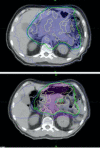Pathologic Complete Response After Neoadjuvant Chemoradiation in a Patient with Gastric Neuroendocrine Cancer
- PMID: 31565618
- PMCID: PMC6758975
- DOI: 10.7759/cureus.5214
Pathologic Complete Response After Neoadjuvant Chemoradiation in a Patient with Gastric Neuroendocrine Cancer
Abstract
Neuroendocrine tumors are about 0.5% of all malignancies. Specifically, for gastrointestinal (GI) malignancies, neuroendocrine tumor incidence is approximately 1%-2% per year. Gastric neuroendocrine neoplasms are rare and consist of various tumor types with differing histomorphology, pathogenesis, and biological behavior. Following surgery, post-operative chemotherapy is generally considered the standard of care. Our case report demonstrates the potential benefit of neoadjuvant concurrent chemoradiotherapy prior to surgery for a malignant gastric neuroendocrine tumor. While radiotherapy has been demonstrated to possibly provide a survival benefit in the treatment of GI neuroendocrine tumors, its use in treatment, particularly neoadjuvantly, needs to be further assessed.
Keywords: gastric; neuroendocrine cancer; radiation therapy.
Copyright © 2019, Laughlin et al.
Conflict of interest statement
The authors have declared that no competing interests exist.
Figures


Similar articles
-
CEA - a predictor for pathologic complete response after neoadjuvant therapy for rectal cancer.Dis Colon Rectum. 2013 Jul;56(7):859-68. doi: 10.1097/DCR.0b013e31828e5a72. Dis Colon Rectum. 2013. PMID: 23739192
-
Predictive Significance of Mucinous Histology on Pathologic Complete Response Rate Following Capecitabine-Based Neoadjuvant Chemoradiation in Rectal Cancer: a Comparative Study.J Gastrointest Cancer. 2019 Dec;50(4):716-722. doi: 10.1007/s12029-018-0136-x. J Gastrointest Cancer. 2019. PMID: 29984382
-
Neoadjuvant chemoradiotherapy with concurrent cisplatin/5-fluorouracil is associated with increased pathologic complete response and improved survival compared to carboplatin/paclitaxel in patients with locally advanced esophageal cancer.Dis Esophagus. 2017 Jul 1;30(7):1-7. doi: 10.1093/dote/dox015. Dis Esophagus. 2017. PMID: 28475724
-
Neoadjuvant chemoradiotherapy followed by surgery for stage IIIa and IIIb non-small-cell lung cancer (NSCLC): is it still justified?Chin Clin Oncol. 2015 Dec;4(4):49. doi: 10.3978/j.issn.2304-3865.2015.12.05. Chin Clin Oncol. 2015. PMID: 26730761 Review.
-
Chemoradiation therapy in the management of gastrointestinal malignancies.Future Oncol. 2011 Mar;7(3):409-26. doi: 10.2217/fon.11.7. Future Oncol. 2011. PMID: 21417904 Review.
Cited by
-
Neoadjuvant chemotherapy improves the survival of patients with neuroendocrine carcinoma and mixed adenoneuroendocrine carcinoma of the stomach.J Cancer Res Clin Oncol. 2020 Aug;146(8):2135-2142. doi: 10.1007/s00432-020-03214-w. Epub 2020 Apr 18. J Cancer Res Clin Oncol. 2020. PMID: 32306127 Free PMC article.
References
-
- Diagnosis and treatment of gastric neuroendocrine tumours. Plockinger U. Wien Klin Wochenschr. 2007;119:570–572. - PubMed
Publication types
LinkOut - more resources
Full Text Sources
